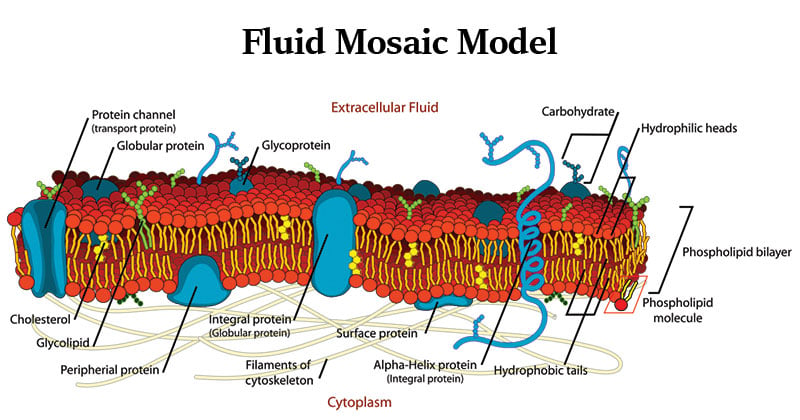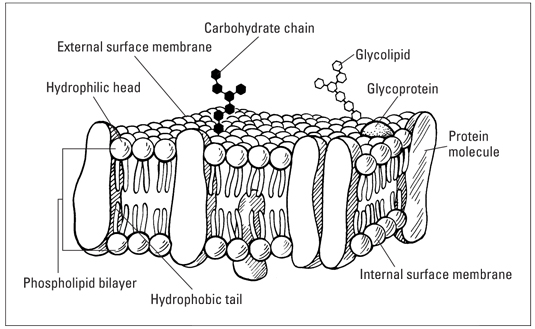The phospholipid bilayer forms a mosiac of components as the bilayer is embedded with View the full answer. Cell membrane overview and fluid mosaic model.

5 1b Fluid Mosaic Model Biology Libretexts
The plasma membrane is composed of a bilayer of phospholipids with their hydrophobic fatty acid tails in contact with each other.

. Both animal and plant cell membranes contain sterols. The diverse proteins found in and attached to membranes perform many important functions. Other Apps - April 13 2022 Plasma Membrane Plasma Membrane Eukaryotic Cell Cell Membrane Structure Fluid Mosaic Model Of The Cell Membrane Youtube Cell Membrane Structure Membrane Structure Cell Membrane.
It indicates that the cell membrane is not solid. It is flexible and has a similar consistency to vegetable oil so all the individual molecules are just floating in a fluid medium and they are all capable of moving sideways within the cell membrane. The fluid mosaic model is a model of the cell membrane that explains how the components are able to move freely laterally in the bilayer and that the membrane is able to flex and bend with the cell.
A fluid mosaic model is presented for the gross organization and structure of the proteins and lipids of biological membranes. The fluid mosaic model of membrane structure is a cell membrane that behaves like a two- dimensional liquid of mixed composition. The cell membrane is often call the Fluid Mosaic because many of the proteins and phospholipids are free to move laterally as the temperature fluctuates.
Cell membrane overview and fluid mosaic model. Discuss the role of the membrane in the movement of materials through it by each of the following processes. The cell membrane is described to be fluid because of its hydrophobic components that are integrated into the membrane structure such as lipids and membrane proteins that move sideways throughout the membrane.
For example myelin contains 18 protein and 76 lipid. In the fluid mosaic model phospholipids form a lipid bilayer in which the nonpolar regions or the fatty. The plasma membrane.
The fluid music model describes the structure of the plasma membrane as a music of components including forceful lipids cholesterol proteins and carbohydrates that gives the membrane a fluid director proportions of proteins lipids and carbohydrates in the plasma membrane very very vivid cell type. According to this model the plasma membrane is made of a phospholipid bilayer with cholesterol protein and carbohydrate molecules embedded in it. A membrane has proteins and other components embedded among the phospholipidsExplanation.
This membrane is 5-10nm in thickness. The phospholipid is formed of two layers of phospholipid molecules with the polar. For example myelin contains 18 protein and 76 lipid.
Describe the structure of cell membrane using fluid mosaic model Answer. The fluid mosaic model describes the structure of the plasma membrane as a mosaic of components including phospholipids cholesterol proteins and carbohydratesthat gives the membrane a fluid character. The fluid mosaic model of the plasma membrane describes the plasma membrane as a solid inflexible structure with a certain distribution of proteins that does not vary from cell to cell asked Nov 14 2020 in Biology Microbiology by brenditah.
Mosaic refers to something that contains many different. Biologist Use the Fluid Mosaic Model to Describe Get link. The model is consistent with the restrictions imposed by thermodynamics.
Science APCollege Biology Cell structure and function Membrane permeability. Passive transport The plasma membrane is a semi permeable barrier that separates the inside of the cell from the outside environment. The framework of a membrane is a bilayer of phospholipids with their hydrophilic heads facing the aqueous environment inside and outside of the cell and their hydrophobic.
The fluid mosaic model describes the structure of the plasma membrane as a mosaic of components including phospholipids cholesterol proteins and carbohydratesthat gives the membrane a fluid characterPlasma membranes range from 5 to 10 nm in thickness. Plasma membranes range from 5 to 10 nm in thickness. For comparison human red blood cells visible via light microscopy are approximately 8 µm.
The fluid mosaic model describes the cell membrane as a tapestry of several types of molecules phospholipids cholesterols and proteins that are constantly moving. This movement helps the cell membrane maintain its role as a barrier between the in View the full answer. The fluid mosaic model described the plasma membrane that.
The fluid mosaic model describes the cell. The modern understanding of the plasma membrane is referred to as the fluid mosaic model. Plasma membranes range from 5 to 10 nm in thickness.
Describe the fluid-mosaic model of a plasma membrane. The fluid mosaic model describes the structure of the plasma membrane as a mosaic of components including phospholipids cholesterol proteins and carbohydratesthat gives the membrane a fluid character. Plasma membranes range from 5 -10 nm in thickness.
Cell membranes are represented by using a Fluid mosaic model because the phospholipid bilayer is viscous Fluid and individual phospholipids can move. The mosaic model of membrane structure describes the structure of the plasma membrane as a mosaic of components including phospholipids proteins carbohydrates cholesterol and proteins that gives the membrane a fluid character. The fluid mosaic model describes the structure of a cell membrane.
Because membranes are fluid membrane proteins and phospholipids can drift about in the membrane. In this model the proteins that are integral to the membrane are a heterogeneous set of globular molecules each arranged in an amphipathic structure that is. The fluid mosaic model describes the structure of the plasma membrane as a.
The fluid mosaic model of the plasma membrane was given by Singer and Nicolson in 1972. Describe the Fluid Mosaic model of membrane structure. Please include your description of the types of protein found in the membrane and their function.
The fluid mosaic model explains various observations regarding the structure of functional cell membranesAccording to this biological model there is a lipid bilayer two molecules thick layer consisting primarily of amphipathic phospholipids in which protein molecules are embedded. Structure of the Cell Membrane. The proportions of proteins lipids and carbohydrates in the plasma membrane are different.
Heads face the aqueous medium surrounding membrane Some phospholipid tails are saturated and some unsaturated. Features of the fluid mosaic model Membrane is bilayer of phospholipid molecules that move about by diffusion within their own monolayer Phospholipid tails point inwards and form a non-polar hydrophobic interior. Ad Over 27000 video lessons and other resources youre guaranteed to find what you need.
The landscape of the membrane is studded with proteins some of which span the membrane. This is the currently selected item.

Fluid Mosaic Model Cell Biology

Topic 1 3 Membrane Structure Amazing World Of Science With Mr Green

A Fluid Mosaic Model Of The Cell Membrane Membrane Proteins Are Download Scientific Diagram
0 Comments